Thai holiday part 3: The Northern Hill Tribes

Meikyo
Phil and Sarah Tadd
Sun 3 Aug 2025 09:53
|
We fitted in a quick visit to the White Temple, in Chiang Rai on our way north from Chiang Mai. This is a modern temple and is not yet complete, with some buildings missing their decorations. We were able to visit the workshop where decorations, made of plaster
with pieces of silver mirror stuck on them, were being made. From here we exchanged our coach for a minibus to be driven up steep and winding roads to the hill village of Doi Mae Salong. The majority of the villagers here are ethnic Chinese after members
of the Kuomintang, fleeing China via Burma were allowed to settle. They were seen as a buffer against the communists in China and were allowed to keep weapons. Once major growers of opium they now farm tea instead, and the next day we visited a tea plantation
for a tasting. Lower down the mountain we visited a small farm where we cooked our own lunch over charcoal braziers using ingredients from the farm.
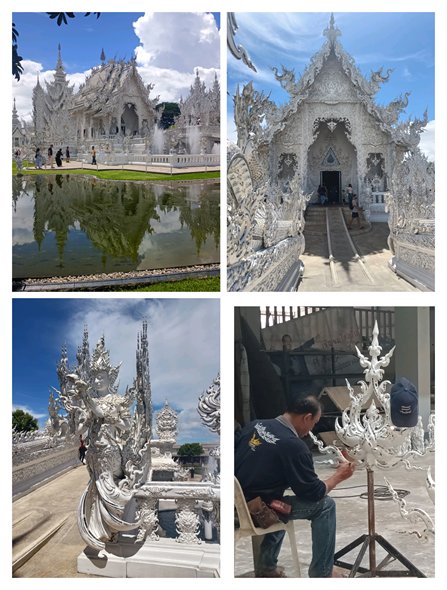
The White Temple
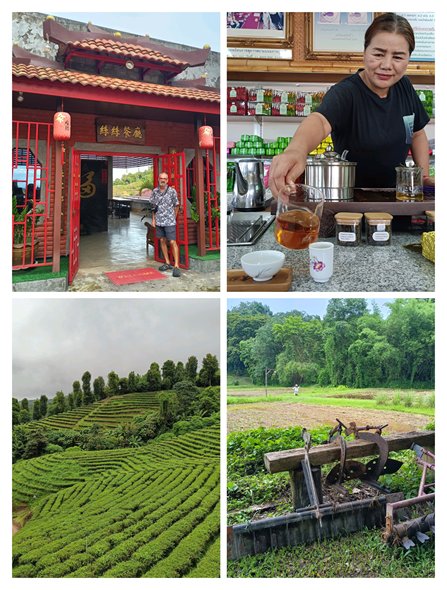
Our guest house in Doi Mae Salong, tea tasting at a plantation, and the farm
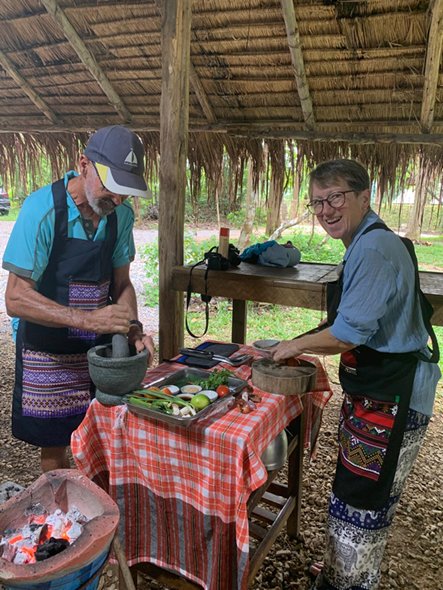
Preparing our lunch on the farm
We had one night in Chiang Rai, in a lovely little hotel built round a courtyard with water features, before leaving for our 3 day trek among the hill tribes. This night the weather, which had been quite dry since our raft trip, broke with a terrific thunderstorm
that was to set the tone for the trek. It was dry again by the time we clambered out of the back of our transport, a small truck with two bench seats facing each other in the back. We were met by our local guide A Mel, who handed us each a bamboo walking
stick. We were told that A Mel would lead the way to check the path for snakes, scorpions and spiders and we were to give him at least 2 meters space so he could swing his knife to clear the path for us. Leeches were not likely until the second day!
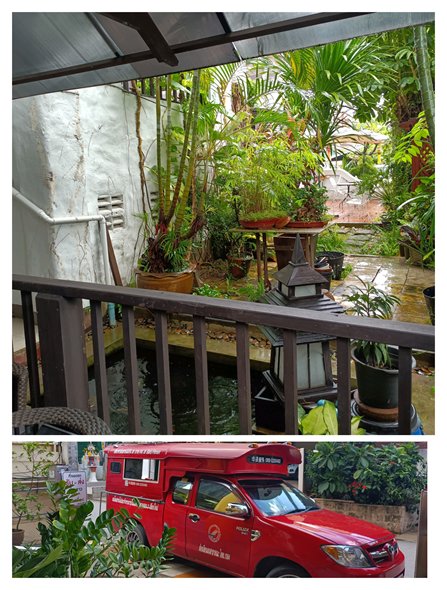
Looking out from our room into the courtyard of the hotel in Chiang Rai. It was great to come back here after the trek. The local taxi with benches facing each other in the back
The walking was up and down along tracks to start and then onto overgrown footpaths through bamboo forest, teak trees and small rubber plantations. We saw the villagers heading into the forest to collect mushrooms, which they can sell at the market for a price
that seemed very low to us. Just before our lunch stop A Mel disappeared into the forest and reappeared with a long bamboo pole over his shoulder. When we stopped he made a fire to keep the mosquitos at bay then made chop sticks and cups for us from the
bamboo pole. Our lunch was fried rice wrapped in banana leaves and huge slices of watermelon, all produced from his rucksack.
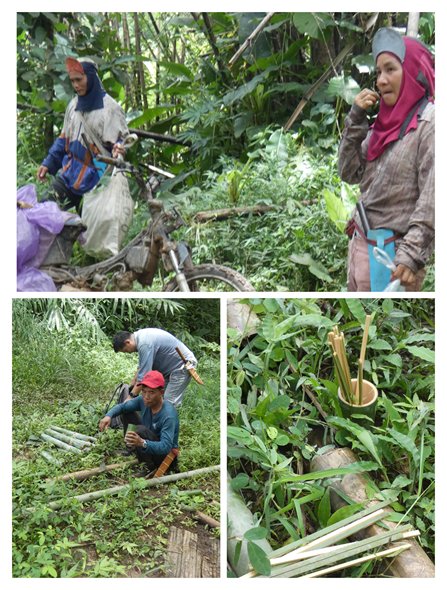
These local villagers had parked their motorbike next to our lunch spot while they collected mushrooms. They disappeared off on the bike with two large full bags down a narrow, muddy footpath. Below A Mel makes a bamboo cup, and biodegradable chopsticks
Our overnight stop was at A Mel’s village, A Pha Pattaya, where we were hosted by his mother, A Mha. The village belongs to the Akha tribe, who migrated from China, and all names begin with A. We had mattresses and mosquito nets inside a thatched bamboo hut,
and tables under the overhang for dinner, which was cooked by our hosts over an open fire and included mushroom soup foraged by A Mel during the afternoon. Toilet huts were a short walk away and that soon became a quagmire when the rain arrived just after
we did.

Sheltering from the rain on arrival at our homestay. A Ma and A Mel cooked our meals, and made lunch for the next day, wrapped in banana leaves
Day 2 was the longest walk. It was similar to day one to start, until our lunch break at a waterfall. After lunch we climbed steadily up the ‘Big Mama Hill’ (Damrong’s description) to a viewpoint where we could see all the way to Chiang Rai. It was a hard
climb, but made interesting as we went up through farmland, seeing villagers working the rice paddies cut into the hill and tending their livestock. A steady descent bought us to our second overnight stop at Yafu, a village of the Lahu tribe who originated
in Tibet. The bamboo huts here were on stilts and built into the hillside. Given the heavy rain we went to bed thinking about the possibility of land slips.
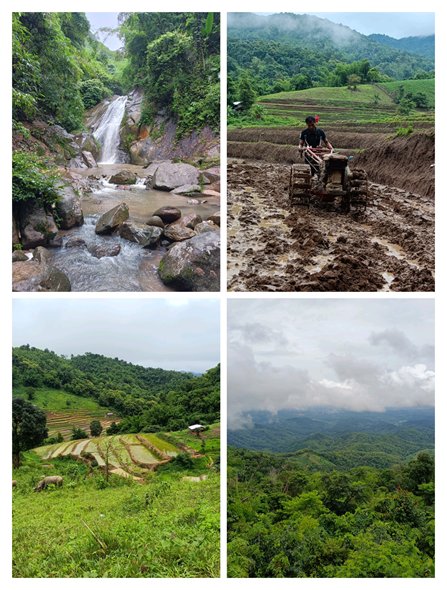
A refreshing lunch stop at a waterfall on day 2, before the long climb up past the paddy fields to the view point.
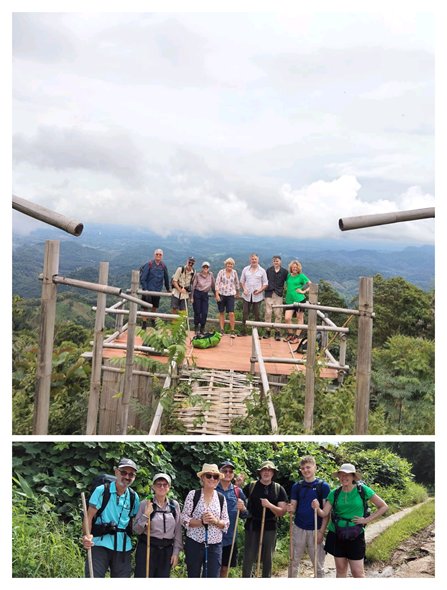
Our group at the bottom of the trek (from left: us, Rozelle, Ian, Frazer, Elliot and Fenn) and at the highest point

Our second overnight stop, with the huts built into the hillside
Day 3 was a steady descent to our finish point. The highlight of this day was to be a soak in a natural hot spring, but the pool was closed for cleaning so we just got to soak our feet before lunch and our return to Chiang Rai.
We were now winding down to the end of the holiday and the next day we caught the bus to Chiang Mai for the overnight train back to Bangkok. We had a free day in the capital and we used it to visit some of the attractions we had missed first time round. We caught the commuter boat down river to the central pier, where we changed to the Skytrain. We got a glimpse of Bangkok’s tallest tower on our way to the Arts Museum. Much of the museum’s exhibits appeared to be student work and a bit modern for our tastes, but there was an interesting exhibition on the top floor that told the story of an earlier King’s life in black and white photos. From there it was a short walk to Jim Thompson’s house, now a museum by one of the canals. Thompson was known as the founder of the modern Thai silk industry. An American who trained as an architect before military service took him to South East Asia, his house is a fusion of traditional Thai design with western styles and house and gardens were beautiful. The examples of silk were also lovely, but out of our price range! 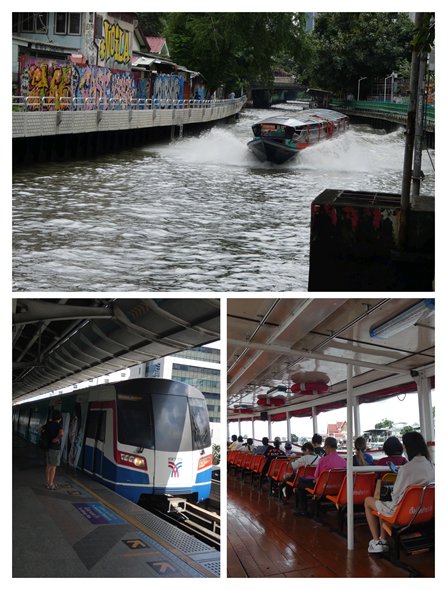
Canal boat, skytrain and commuter boat
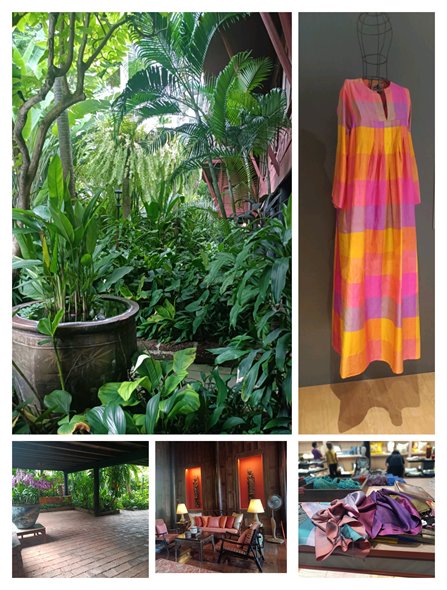
Jim Thompson's house
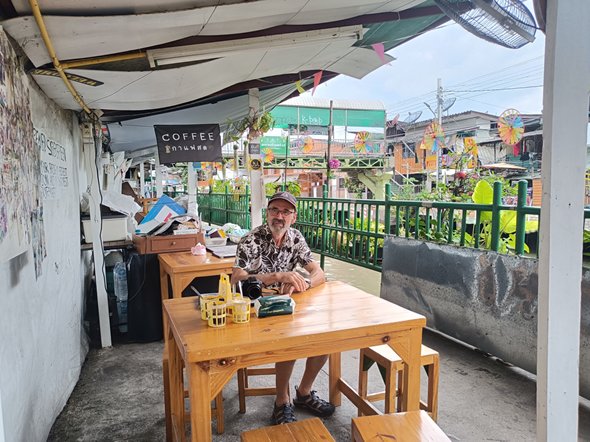
Lunch by the canal
After lunch at a small canal side restaurant, we caught the canal boat back to its terminus at the Golden Mountain temple and walked back to our hotel. That evening we had a last dinner with our tour group and guides then, the next morning, were up at 0400
for our journey back to Pangkor. Taxi, plane, 6 hour coach trip and a Grab ride (Asian Uber) and we were home for 8pm.
We are now busy with boat work, so will not be blogging as much until we are back sailing again.
|